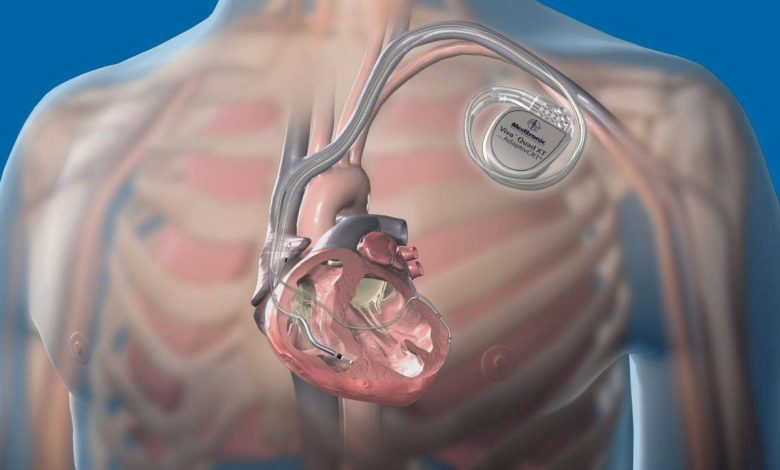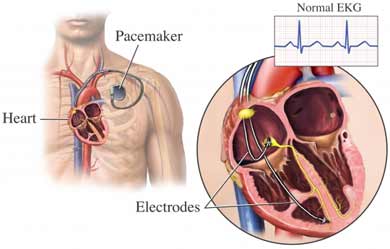Heart pacemaker: for what, how to install, Contraindications, what after

Description of pacemaker installation
The procedure is done, to establish elektorokardiostimulyator. Kardiostimuljator – a small device, It operates on battery, which helps maintain normal heart contractions, sending electrical pulses to the heart.

Reasons for installing a pacemaker
A pacemaker can be installed in the following cases:
- The natural pacemaker of the body, sinoatrial (on) node, It does not work properly. When the SA node is not working correctly, the heart can beat too slowly;
- Any malfunction of the atrioventricular (OF) node, part of the electrical system of the heart, which sends signals from the SA node to the ventricles. This leads to a very slow heartbeat;
- It must be improved heart function in people with severe symptoms of congestive heart failure and weakened heart muscle (cardiomyopathy);
- After the heart surgery.
Possible Complications of Pacemaker Insertion
Complications are rare, but the procedure does not guarantee the absence of risk. If you plan to install a pacemaker, the doctor will review a list of possible complications, which may include:
- Heavy bleeding;
- Infection;
- Pacemaker Malfunction;
- Rupture of the heart muscle (rarely);
- Unnecessary in this case, the stimulation of the diaphragm (more muscle between the chest and abdominal cavities).
Factors, that may increase the risk of complications:
- Obesity;
- Smoking;
- Excessive alcohol consumption;
- Bleeding or blood clotting disorders;
- Regular use of certain drugs.
We need to discuss these risks with your doctor before the procedure.
How is a pacemaker installed??
Preparation for the procedure
Before the procedure, the doctor may prescribe:
- Blood tests;
- Chest X-ray – test, which uses X-rays, to photograph the structure within the breast;
- Electrocardiogram – test, that records heart activity by measuring electrical current through the heart muscle.
A few days before the procedure:
- Consult your doctor about the drugs taken. A week before surgery you may be asked to stop taking some medicines:
- Anti-inflammatory drugs (eg, aspirin);
- Blood thinners, such as clopidogrel (Plaviks) or warfarin (Coumadin);
- Eat a light meal the night before the procedure. Do not eat or drink anything after midnight.
Anesthesia
It will use local anesthesia. It means, that will numb only the area of the operation. Anesthesia is given by injection.
Description of the pacemaker insertion procedure
You will lie on a hard table. Will control the heart rhythm, blood pressure and respiration. The doctor performs a small incision under the collarbone. Through this incision will be inserted pacemaker. The wires through a vein under the collarbone to the heart are brought. After installation is complete, the incision is sewn stitches.
Immediately after the pacemaker insertion procedure
Will monitor your heart rate and blood pressure.
How much time it will take the installation of the pacemaker?
About 2 hours.
Installing a pacemaker – Will it hurt?
Anesthesia will prevent pain during surgery. You may have pain and soreness after surgery. The doctor will give you pain medicine, to reduce discomfort.
Post-pacemaker care
Before, leaving hospital, the pacemaker will be programmed according to the needs stimulation. When you return home, Follow these steps:, to ensure the normal recovery:
- Ask the doctor, when it is safe to shower, bathe or expose the surgical site to water;
- As soon as you feel OK, You can return to daily activities. It may take about two weeks;
- During 4-6 weeks, avoid physical exertion, especially those involving the upper body;
- Avoid excessive movement of the hand / arm on the side of the installation of the pacemaker for two weeks. This will help avoid bias wires;
- Do not drive for one week after surgery;
- The sutures are removed at one week;
- Procedures, that should be avoided after installing the pacemaker:
- MRT;
- Heat therapy (It is often used in physiotherapy);
- High-voltage or radar machinery (eg, arc welding, high voltage wires, radar installations, or smelting furnaces);
- Radio and television transmitters;
- Do not carry a cell phone in a pocket directly over the device. Besides, headphones and MP3-players around the pacemaker may cause interference;
- Turn off the car's engine or outboard motor when working near them. (They can “confusing” device);
- Tell your doctor and dentist, that you have a pacemaker;
- Talk to your doctor about the safety of passing through airport security detectors with your device;
- Be sure to follow your doctor's instructions.
The skin along the incision may form a solid ridge, which usually resolves, When the wound heals.
Communication with the doctor after the installation of a pacemaker
After discharge from the hospital need to see a doctor, If the following symptoms:
- Signs of infection, including fever and chills;
- Redness, edema, strong pain, excessive bleeding, or any discharge from the incision;
- Pain, which does not pass after taking pain medication appointed;
- Cough, breathlessness, chest pain;
- Irregular heartbeat;
- New disease symptoms.
In the event of a life-threatening situation, you should immediately seek medical help.
